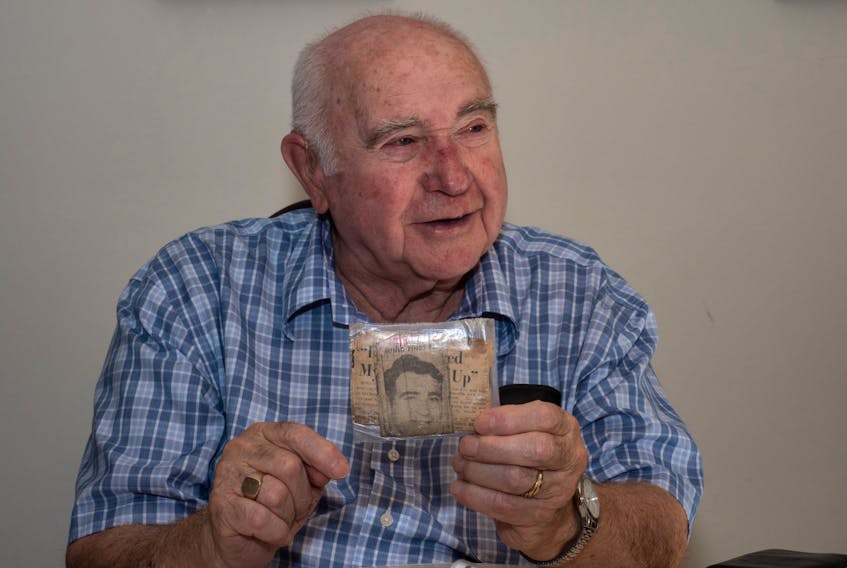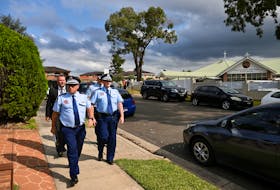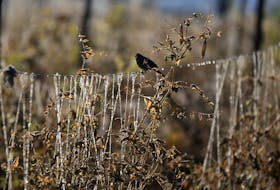For Harold Brine, it boiled down to whether his will to survive was stronger than the possible fate of being forever entombed deep underground after Nova Scotia’s worst mining disaster, 60 years ago.
“I thought I’d never see daylight again,” the 86-year-old former miner recalled of being trapped for five days with 11 companions in a cavern near the bottom of Dominion Steel and Coal Corporation’s No. 2 Colliery in Springhill, Cumberland County.
An Oct. 23, 1958 bump — an underground upheaval similar to an earthquake — ripped apart the lower section of the 4.3-kilometre-long sloping shaft in which Brine and 173 other miners were working. Seventy-five of them died in the disaster in one of the world’s deepest mines.
RELATED: John DeMont talks to Herald photographer who helped bring Springhill disaster to world
In the main shaft that stretched more than 1.2 kilometres below the surface, the force of the brief but powerful bump lifted the floor of the 2.5-metre-high tunnel into the ceiling. Many miners were crushed or were buried under tonnes of broken coal from walls and ceilings.
But in some areas, the bump’s rippling effect lifted the floor only halfway, leaving a narrow pocket of survival.
“I thought we were done with,” Brine, the last surviving rescued miner, said in a recent interview at his Geary, N.B. home. “I wondered how long we could last with nothing to eat and nothing to drink.”
Even drinking his own urine failed to quench his constant thirst for water. But his despair was countered by his intense desire to be reunited with his wife and daughter on the surface.
“I had a little two-year-old (Bonnie) who had to go through life and I wondered if she would remember me,” he said. “That was one of the things I worried about the most.”
The Springhill native was just 20 when he first went down into the mines in 1951. Coal was at the time the economic backbone of the community of about 4,000 residents.
“I wanted to get married and needed more money,” he said of initially doing timber and shoring work before digging with pick and axe on the coal face.
But, what happened at 8:06 p.m. on that October 1958 evening is forever etched in his memory.
Brine recalled working with three other men — Herbie Guthro, Joe Holloway and Teddy Michniack — on a coal seam wall at the 4,200-metre level when the violent upheaval occurred.
“I was near the top of the (ceiling), pulling some coal down when it happened. It hit me and I don’t know, it marked my ribs and split my ear open. It kind of knocked me out. I was dazed.
“When I came to, Herbie and Joe were right below me. They were both buried by coal pushed out from the face of the wall. I helped dig them out.”
Brine recalled a couple of smaller tremors earlier in his shift, but noted it was a common occurrence in the mine. “I had no idea the last one was going to be as bad as it was.”
He passed two dead miners as he crawled up the narrow shaft in an effort to find a way out.
But there was a cave-in, and as “I crawled up over the stone, the methane gas almost put me out. The boys grabbed me by the feet and pulled me down off the rock close to the floor where the air was good. At that point, we figured we couldn’t get out.”
Brine said their escape was also blocked by another cave-in below.
“We were in quite a big hole about four feet high. We could move around. Originally there were four of us. Where the others guys came from, I don’t know.”
Two of those trapped were seriously injured, he said, including one with a “busted hip.”
“They suffered the whole time we were down there.”
But the rest were in relatively good physical and mental shape, he noted. Before their battery-operated head lamps died about 12 hours later, Brine said they took stock of where everyone was.
“We were all sitting on top of the coal like in a circle.”
During their five day ordeal, the trapped miners could hear the sound of rescuers using compressed air-driven chipper picks. But because of the acoustics of sound travelling through the coal seam, they couldn’t determine just how far away they were.
“We knew they were working towards us — but could they get to us in time?”
Brine said one of the miners had a small aspirin bottle that was used to ration water from a half-filled can found in the tunnel.
“But that didn’t last very long.”
It wasn’t long before some of them began urinating in the can and drinking from it. Although forced air from the surface was still getting into the pocket and cleaning the air, Brine said they had to stay low to avoid a gas buildup over their heads.
“There was no panic and nobody got excited,” he said. “We all just sat there hoping to survive.”
He praised fellow miner Caleb Rushton for encouraging the trapped men to “take time to have a little song and time to have a little prayer.”
“My concern was how we were we going to die. Would it be from hunger or from thirst? Never thought of food, all I thought of was water.”
In the meantime, they pounded on a steel pipe in the hope of being heard.
Rescuers were finally able to punch a 27-metre pipe through the debris and communicate with those on the other side.
“We told them how many of us were trapped, how many were hurt and if we were aware of any other trapped miners.”
“All we wanted was water. Just give us some water,” he said of yelling through the metal pipe.
Brine said when the trapped men were brought out of the mine in baskets, they were advised to cover their eyes to protect them from lights and camera flashes.
Ironically, Brine was a draegerman (mine-rescue worker) who went down the adjacent No. 4 colliery after an explosion two years earlier that claimed the lives of 39 miners.
Two months after the bump, he and his family packed up their things and drove to Ontario so he could search for another job.
“My wife’s parents were up there,” he said. “I knew there was nothing left for me in Springhill.”
Brine said his only regret was never having the chance to thank all the guys who risked their lives to save him.
“You would think there would have been a get-together to say thank-you to those who rescued you,” he said. “But there wasn’t.”
READ MORE:
- Did Springhill miners see the bump coming? A look at the science behind the 1958 mining disaster
- A town that rises from overwhelming adversity: Springhill changed forever following 1958 mine disaster
- ‘A night to honour the men who lost their lives’: Hymn sing planned Oct. 23 to mark Springhill bump
- Last man out of Springhill mine after 1958 bump dies
- Singing Miner’s daughters to perform at hymn sing marking 60th anniversary of Springhill disaster









